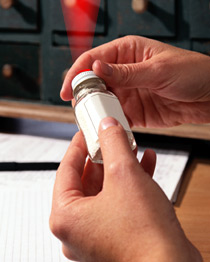Material Fingerprints
Laser Surface Authentication (LSA) is an authentication process to spot manufactured counterfeits. As authentic items come off the assembly line a laser scans their surface and measures the scattered beams. Every batch of material will have its own signature. The material signature can be applied to ID cards. The technology is being developed by Ingenia, based in the UK.
A scanner with a low power focused laser beam scans across the surface of the item to be identified. The document or card is placed flat on the top of the scanner and pushed by hand until two of its edges press against guide rails. This ensures that the same part of the document is scanned each time. During the scan, the scanner records a large number of details of the way the laser light is reflected off the surface of the paper or plastic.
Microscopic irregularities on the surface due to the structure of the paper fibres or the setting of the plastic result in complex scattering of the laser beam, through the optical phenomenon of ‘speckle’. This forms the basis of a signature which is unique to any given sheet of paper or plastic. The scanner is sufficiently sensitive to detect surface irregularities of less than a few hundred nanometers in size.
Genuine documents, cards and packaging would have their fingerprint read on the way out of the issuing agency or factory. The fingerprint is then stored either in a central database or is written onto the item using an encrypted barcode. In order to check the validity of the item later in the field, the fingerprint would be re-read and compared against the database or against the barcode.



